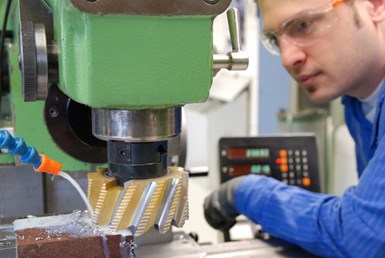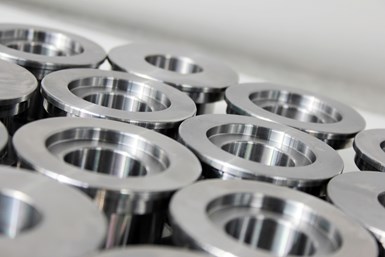Share
Disruptions in the supply chain are a fact of life that every manufacturer must deal with. At every point in the chain, companies are experiencing difficulties sourcing material and equipment, leading to production delays and lost work for manufacturers and job shops. With disruptions staying for the foreseeable future, dealing with these challenges no longer means just merely enduring them.
No one can completely insulate themselves from supply chain chaos, but adequate preparation can make the changes easier to ride out.
Many shops are turning to Enterprise Resource Planning (ERP) and shop management solutions that can improve the shop’s ability to source material and keep jobs moving as much as possible.
Planning Ahead for Supply Chain Disruption
Whether you are a production manufacturer or a smaller job shop, material supply issues directly impact your business. ERPs and shop management solutions are available that are specifically built to help manufacturers both big and small understand what is happening on and off their shop floors, back office, and operations. With this improved access to shop floor and operations data, they can have the real-time insight to be proactive and
ERP systems benefit manufacturers by making accurate information from all areas of the facility readily available.
flexible with the uncertainties that unreliable supply chains bring.
The basic function of an ERP system is to collect various pieces of information from the shop floor, operations, and all relevant departments and make it easily accessible. “ERP systems put your material stock, machine availability and more in one place,” says Tim Watkins of ECI Software Solutions. “This means that when you’re looking at a job and you’re asking if you have the material, if you have the tooling, or if it will be late, you will be able to answer those questions without having to chase down the information.”
According to Watkins, ERP systems enable shops to tackle supply chain issues through five primary benefits:
- Visibility: Having facility information from all aspects of your business in a single, easy-to access program.
- Accuracy: Having accurate information on material stock, machine schedules and vendor prices.
- Dependability: With cloud-based ERP, the servers needed to keep your shop operating at full capacity are maintained by the ERP company, not you.
- Reviewability: Looking back on past jobs and learning which vendors were reliable and which items you might want to keep in stock long-term.
With the supply chain in chaos, machine shops that want to keep making parts may need the benefits of an ERP to deliver parts on time.
ERP systems bring visibility to fluctuating prices and shortages. “One of our product add-ons that deal with alerts and automations can actually run multiple vendor automations to keep material prices up to date for your purchasing department to make informed and profitable decisions on each and every order,” says Watkins. “No one can completely insulate themselves from supply chain chaos, but adequate preparation can make the changes easier to ride out.” ERPs enable your shop to adapt nimbly to the fluctuations in prices and material availability that plague us all.
It is also vital to remember that ERPs replace tribal knowledge with automation. “If you have one guy who knows who to talk to at the supplier’s warehouse to get reliable answers on when material is going to ship,” Watkins says, “then your whole organization depends on him being at work. What happens when he gets sick or retires?” This is especially helpful when the supply chain is chaotic, as knowing who to speak to when problems occur is vital. ERP systems enable organizations to centralize that tribal knowledge and insulate themselves from the chaos of life.
ERP systems connect the office to the shop floor and vice versa. This creates the visibility necessary for keeping astride of potential issues in the supply chain.
With a sole source of data, ERPs also make it much easier to review the accuracy of quotes. “Being able to look back at what went over on cost, which vendors you could rely on in a pinch, and where you can improve is a major benefit,” Watkins says. “That’s how you fix problems in your process.”
But how do you get the most out of the review process? “Be proactive,” Watkins says. “Have the dock workers take pictures of document arrivals. Use an alert function to keep the QA team up to date.” ERP systems are tools for improving your business, but a shop must be willing to embrace improvements and genuinely examine challenges to get the most out of them.
But how do you know which ERP system is the best fit for your shop? According to Watkins, you need to pay attention to the strengths of each system. Let’s compare two offerings from ECI: JobBOSS² and M1.
Picking the Right ERP: JobBOSS² vs M1
Both of ECI’s ERP solutions are cloud-based software that allow remote access. This makes it easy to connect every station in the shop and eliminates the need for local backup. “So often we see a separation between the shop floor and front office,” Watkins says, “and what our system does is provide a bridge to keep that information flowing and freely available.” However, not every ERP is the same.
According to Watkins, whether a given shop would benefit more from JobBOSS² or M1 depends on four factors: the size of the shop, its volume of parts, its manufacturing process type, and its inventory size. JobBOSS² is designed to be accessible and easy to implement for smaller job shops that trend towards high-mix, low-volume work. One of the greatest gains a shop will get with JobBOSS² is its scheduling capabilities and the easy-to-use interface. “It handles the quote-to-ship process very well for small-to-$5 million companies,” Watkins says. “It provides easy access to material availability for specific jobs, but it is not suited for managing and maintaining a large inventory. Once a shop’s needs grow beyond that, you will typically need the more robust package like that in M1.”
ECI recommends M1 for shops that wish to keep large inventories or that have large volumes of parts to produce. Its ability to forecast inventory needs is vital for keeping ahead of supply chain issues.
The M1 system shares a lot of the functionality of JobBOSS ² but is designed for larger shops, as well as facilities that trend towards high-volume work. It has Purchase Planner, an inventory management system that assists users in buying materials. The software aggregates purchase orders for multiple jobs to buy material in bulk, and it analyzes what a shop will need to fulfill its obligations within a given timeframe. “Any shop that needs to manage a large inventory, and especially high-production shops will find this useful,” says Watkins.
The system is also capable of forecasting inventory needs over longer periods. It can take year-over-year forecasts and suggest long-term purchases, enabling companies to smooth the curve of inventory fluctuations and avoid supply-chain hiccups. “Right now, a lot of organizations are hope-casting more than forecasting,” Watkins says. “They’re buying for work they hope they’ll get. What this system does is analyze what the shop will need and accurately forecasts material needs down the line to keep inventory stocked.”
When you pick an ERP, it is vital that you consider your shop’s current and future needs. Less expensive options that provide simpler features are a smart choice for smaller shops with fewer inventory needs. However, a large shop will see many benefits from investing in a more complete package like M1.
For more information, check out ecisolutions.com.




